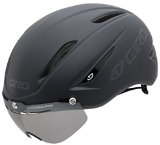Traditionally, aerodynamic cycling helmets have relied on sloping shapes, minimal venting, and a teardrop tail design to dictate the flow of air in order to overcome aerodynamic drag. However, with Giro’s new Air Attack Shield, its engineers had to rethink the shape of this typical design. The reason for this was simple — the objective of the Air Attack was to mate an aerodynamic helmet with a design that was compact, well-ventilated, and able to be worn for long periods of time. To start, the helmet was designed with a similar frontal area as Giro’s Selector time trial helmet, only with a new ‘chopped-off’ rear section. Wind tunnel testing proved that the air still ‘thinks’ it’s moving around a long tail, when, in fact, the excess material no longer exists. In addition to now having roughly the same minimal drag (only 11% more) than the Selector, the Air Attack provides a drastic increase in weight savings. In fact, the claimed weight of the Air Attack (without the shield attached) is 264g versus the Selector’s 430g. The second major consideration when designing the Air Attack came down to thermodynamics. After all, Giro’s engineers knew that a lightweight, aerodynamic helmet was worthless to the peloton if didn’t ventilate well. This led Giro to the development of what it calls ‘the Therminator,’ which is a head-form heated to the temperature of a human, with ‘thermo-couples’ added on the outside. The information relayed from this system allowed engineers to map out parts of the head that stayed both cool and warm in the wind tunnel, which let Giro locate where vents were working and where they were not. What Giro found was that as air hits the rider, there is a very high pressure zone right at the forehead. In response, the Air Attack’s new fit system, known as Roc Loc Air, suspends the rider’s head off of the EPS, allowing air entered in that front three millimeter portion of the helmet to flow over the top of the head and out the large, strategically plac…


